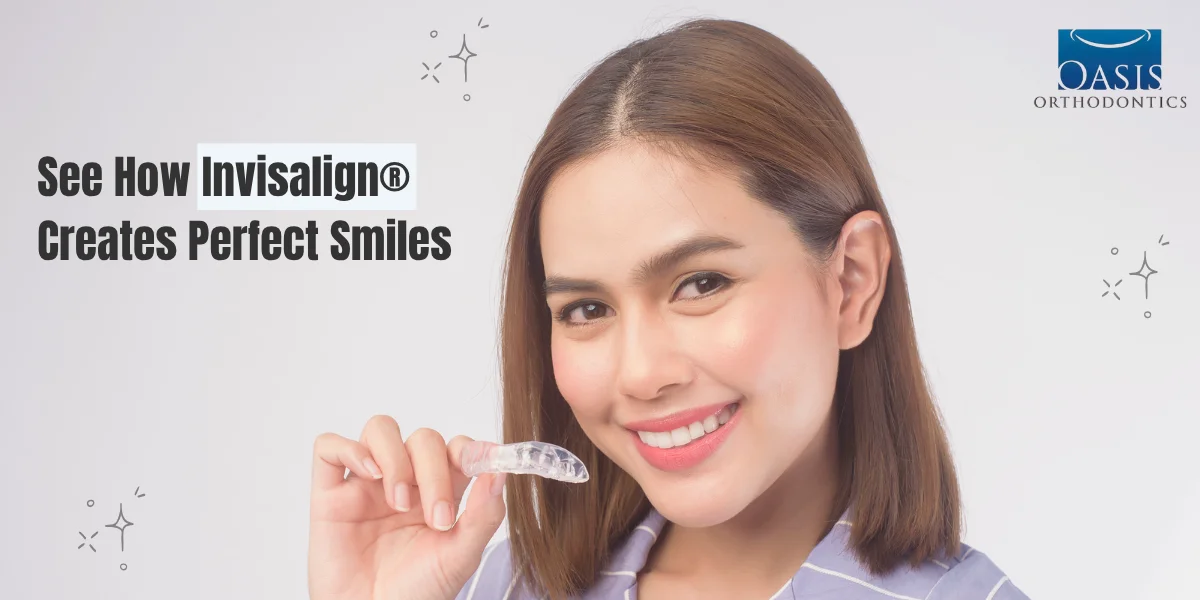How can something as simple as a clear plastic tray move your teeth? That’s the magic behind Invisalign, and here’s exactly how it works. Invisalign works by using a series of clear, custom-made aligners that gradually shift your teeth into the correct position. Each aligner applies gentle, controlled pressure to move specific teeth, and you switch to a new set every 1-2 weeks as your teeth progressively straighten.
This revolutionary teeth-straightening system uses advanced 3D technology to map your treatment from start to finish, showing you exactly how your smile will transform. Unlike metal braces that use brackets and wires, Invisalign’s nearly invisible aligners are removable, comfortable, and designed to fit seamlessly into your daily life while delivering the straight smile you want.
What is Invisalign?
Invisalign is the proprietary brand name for a type of clear aligner system used in orthodontic treatment that offers modern teeth-straightening using clear, removable aligners. Made from smooth, BPA-free plastic, these custom-fitted trays are virtually invisible and easily removable for eating, drinking, and oral hygiene.
Unlike conventional braces with brackets and wires, Invisalign aligners fit like a transparent mouthguard over your teeth. Each set is manufactured using advanced 3D imaging technology based on digital scans. The treatment suits adults and teenagers seeking to correct orthodontic issues like crowded teeth, gaps, overbites, underbites, and crossbites while maintaining normal lifestyle routines.
How Does Invisalign Work?
Invisalign works through controlled force and precise timing. Each aligner is slightly different from the previous one, creating gentle pressure that shifts your teeth bit by bit. Think of it like a series of clear molds that guide your teeth to their final destination.
The treatment involves continuous monitoring and regular aligner changes. When you receive your first set of Invisalign aligners, your orthodontist checks that they fit correctly and feel comfortable. Throughout your treatment, you’ll have scheduled appointments to pick up new aligner sets and allow your orthodontist to monitor your progress. You’ll be switching to new aligners frequently, typically every 1-2 weeks, as part of the gradual tooth-shifting process.
The Complete Invisalign Treatment Process
Initial Consultation Your journey starts with a consultation where your orthodontist examines your teeth and discusses your goals. They’ll determine if Invisalign is right for your specific case.
Digital Impressions and X-rays Instead of messy impression molds, digital scanning creates an accurate 3D image of your teeth. X-rays may be taken to see the complete picture of your oral health.
Receiving Your First Aligners Once your aligners arrive, you’ll have a fitting appointment to ensure they fit properly. Your orthodontist will show you how to insert and remove them correctly.
Wearing Your Aligners Each aligner should be worn for 20-22 hours daily. You’ll switch to a new set every 1-2 weeks as directed by your orthodontist.
Regular Check-ups Appointments every 6-8 weeks allow your orthodontist to monitor progress and provide new sets of aligners.
Refinements if Needed Sometimes additional aligners are needed to perfect your smile. This is normal and ensures the best possible results.
Retention Phase After treatment, you’ll wear retainers to keep your teeth in their new positions. This prevents them from shifting back.
What Problems Can Invisalign Fix?
Invisalign can treat many common orthodontic issues:
- Crowded teeth: When there isn’t enough space in your jaw for all teeth
- Gaps between teeth: Spaces that can trap food and affect your smile
- Overbite: Upper teeth extend too far over lower teeth
- Underbite: Lower teeth sit in front of upper teeth
- Crossbite: Some upper teeth sit inside lower teeth
- Open bite: Upper and lower teeth don’t meet when mouth is closed
Complex cases may still require traditional braces, which is why a professional evaluation is important.
Cost Considerations for Invisalign Treatment
The cost of Invisalign varies based on case complexity and treatment duration. Many dental insurance plans in Canada cover orthodontic treatment, including Invisalign, similar to traditional braces coverage.
Most orthodontic practices offer flexible payment options such as monthly payment plans with no interest, insurance benefit maximization, family discounts for multiple patients, and flexible spending account payments. During your consultation, discuss all financial options to find a payment plan that fits your budget.
Final Verdict: Is Invisalign Right for You?
Invisalign is an excellent choice for many patients seeking a discreet, convenient orthodontic solution. The treatment works particularly well for people who have mild to moderate orthodontic problems, can commit to wearing aligners 20-22 hours daily, want a discreet treatment option, prefer removable appliances, and are responsible about following treatment instructions.
The best way to determine if Invisalign is right for you is through a consultation with a qualified orthodontist. They can evaluate your specific case and discuss all your options.
Take the Next Step Toward Your Perfect Smile
Contact Oasis Orthodontics today at (905) 209-1900 or book your consultation online to start your path to a confident, straight smile with Invisalign clear aligners.

